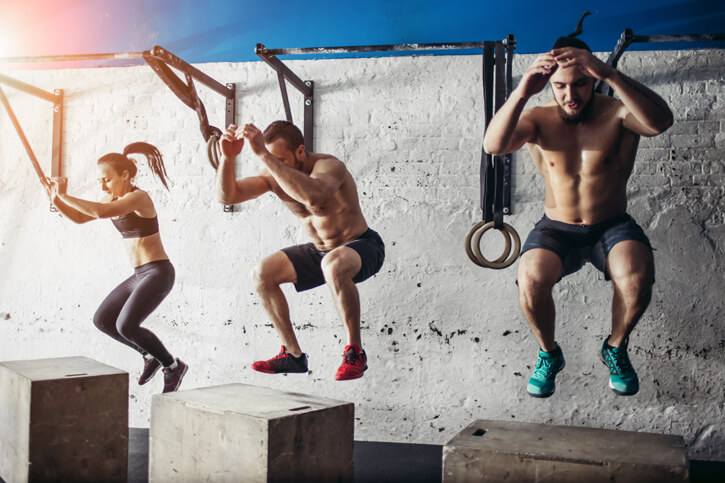Unlock your body’s potential by leaping into Power Training. But what is it? Simply said, power training is by definition STRENGTH multiplied by SPEED. Power training is not just for the athletes or the younger people at your gym. For the purpose of this article, I will focus on Plyometrics. These are drills that uses quick, powerful movements. More specifically, I’ll highlight the classics: Pushups, Medicine Ball Throws, and Jumps.
First, why do you even need to power train? Power training can take on many forms in your regular, everyday life.
For example…
1. Slipping on a wet surface (think shower) and falling towards the ground faster than you are accustom. Your ability to recover and catch yourself can separate a funny story from a real injury.
2. Jumping out of the way of a driver who is texting and not paying attention while you are jogging or walking.
3. Taking the stairs. Granted you COULD walk, but BOUNDING up them two at a time is badass.
4. Playing with your kids. Running is high level, single leg plyometric activity. Do not be the out of shape parent who cannot play basketball or soccer with your kids. You only get so many years with your kids; make them count.
5. Holding a wiggly grandchild
6. Hitting a solid forehand from the baseline in Tennis or driving the ball over 200 yards of the tee in Golf.
7. Getting across a four-lane intersection before the light changes.
Julie Silver, M.D., Chief Editor of Books, Harvard Health Publishing, further explains, “As we age, muscle power ebbs even more swiftly than strength does. So exercises that can produce gains in power become especially important later in life.”
Without further a due, here are the classics and how to scale them up (progress) and down (beginner).
Upper Body Plyometrics
Plyo Push Ups
Explosively push yourself off the floor and clap your hands before you return your hands to the floor to catch yourself.
Beginner (less than 10 pushups): Elevate your hands on a box or bench
Progress (8-10 plyo pushups): Add a double clap or push laterally each rep
Medicine Ball Throws
These are weighted balls (average 6-12 lbs) that are thrown and caught. It is beyond the scope of this article to break down all different forms of the Medicine Ball Throw, so for this example, let’s focus on the Medicine Ball Rotation Throw.
For a beginner, or an older person, simply catching a 6 lbs medicine ball (either from a partner, off a wall, or thrown to themselves) provides a challenge in balance, strength and power not traditionally created by strength machines in the gym.
Seated Medicine Ball Throw and Catch

Progress to More Speed

Progress to a Rapid Change of Direction

For more information, you can pre-order my book Strong Arms.
Lower Body Plyometrics
Vertical Jump – Box Jump
This is simply jumping off the floor on to a box.
Progressing this exercise is easy. Start with a short box and work up to a height you can land in a squat above parallel. Any box height that forces you to land with your knees in your lap is too high and dangerous.
Horizontal Jump – Broad Jump
This is simply jumping forward at a distance. It should be a basic human requirement to able to broad jump your height for healthy adults.
If you can’t jump your height (Beginner): Keep practicing your broad jump to increase your leg strength.
If you can jump your height (Progress): Adding multiple responses, meaning, jump 2 or 3 broad jumps in a row for 1 rep.
For more information, check out my book Strong Legs.
How to Fit Power Training Into Your Program:
After a solid warm up, pick one (1) exercise before your strength training program for the day. Do 3 sets of 5-10 reps of that power exercise. This primes your body for a better workout and place an emphasis on power training that allows you to improve.
MICHAEL VOLKMAR, MS, CSCS, PES, CPT, received his master’s degree in Exercise Science with a specialization in Exercise, Nutrition, and Eating Behavior from George Washington University (GWU). In 2001, Mike started his well-traveled path in Sports Performance Training at the Junior College level (OCC, Onondaga, NY) working with the baseball team. He worked for three years as the Strength and Conditioning Coach at GWU, first with the Single A affiliate (High Desert Mavericks) of the Milwaukee Brewers, and later season with the Double A affiliate (Harrisburg Senators) of the Washington Nationals, before moving on to spend one year at the International Performance Institute of IMG Academies, FL. Mike continued his professional development by becoming the Director of Strength and Conditioning at the APEX Academies. Currently, Mike is the strength and conditioning coach at the Peddie School. A Division I baseball player during his undergraduate career, Mike is an amateur powerlifter with a passion for all things fitness. Mike has advanced specialty certifications in strength and conditioning, post-rehab exercise, athletic development, and sports medicine.






